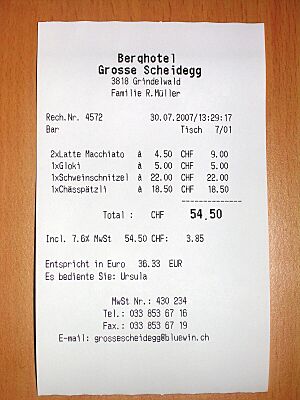Receipt facts for kids
A receipt is a document that proves you have received something. It's often a piece of paper, but it can also be a digital message or even a small, hard object called a token in some places. The word "receipt" comes from "receive," which means "to get."
Receipts are very important because they show proof. They can prove you paid for something, like a new video game or a snack. They can also show that you gave something to someone, like when you drop off your bicycle for repairs.
Contents
What is a Receipt?
A receipt is like a written record of a deal or a transaction. When you buy something, the store gives you a receipt. This paper or digital file confirms that money was exchanged for goods or services. It's a way for both you and the seller to keep track.
Why are Receipts Important?
Receipts serve several key purposes. They help you:
- Prove Payment: If there's ever a question about whether you paid for something, your receipt is the proof.
- Return Items: Most stores require a receipt if you want to return an item you bought.
- Manage Money: Receipts help you see where your money is going, which is useful for budgeting.
- Warranty Claims: For electronics or appliances, receipts prove when you bought the item, which is needed for warranty repairs.
What Information is on a Receipt?
Most receipts have similar information to make them useful. You'll usually find:
- Store Name and Address: This tells you where you made the purchase.
- Date and Time: When the transaction happened.
- Items Purchased: A list of everything you bought.
- Price of Each Item: How much each item cost.
- Total Amount Paid: The final cost, including taxes.
- Payment Method: How you paid (cash, credit card, etc.).
- Transaction Number: A unique code for that specific sale.
Different Kinds of Receipts
Receipts come in various forms today:
- Paper Receipts: These are the most common, printed on small rolls of paper.
- Digital Receipts: Many stores now offer to email you a receipt instead of printing one. This saves paper and makes it easy to store.
- Tokens: In some older systems or specific situations, a physical token might act as a receipt, like a coat check token.
How to Keep Your Receipts Safe
It's a good idea to keep important receipts organized. You can:
- Use a Folder: Keep a physical folder for paper receipts.
- Digital Folders: Create a special folder in your email for digital receipts.
- Take Photos: For very important purchases, you can take a photo of the receipt with your phone.
Keeping receipts safe helps you if you need to return something or check your spending later.
Related pages
See also
 In Spanish: Recibo para niños
In Spanish: Recibo para niños


